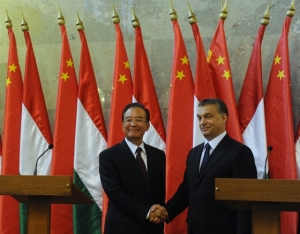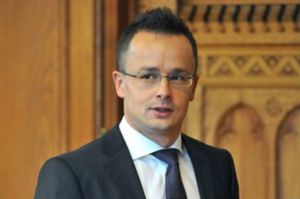Eastern Opening
 The Orbán government pursued a stated policy of Eastern Opening (Keleti Nyitás) from 2010 to 2015. The explicit objective of this policy was to reduce the dependency of Hungary’s economy on trade with the West, particularly fellow European Union members, through increased commerce with countries in the East, particularly China. Eastern Opening represented one of the cornerstones of the second Orbán government’s program and was one of its most frequently cited concrete policies during this five-year period.
The Orbán government pursued a stated policy of Eastern Opening (Keleti Nyitás) from 2010 to 2015. The explicit objective of this policy was to reduce the dependency of Hungary’s economy on trade with the West, particularly fellow European Union members, through increased commerce with countries in the East, particularly China. Eastern Opening represented one of the cornerstones of the second Orbán government’s program and was one of its most frequently cited concrete policies during this five-year period.
Origin
Prime Minister Viktor Orbán introduced his government’s Eastern Opening policy at a September 5, 2010, meeting of the Hungarian Permanent Council in Budapest during which he declared that “We are sailing under a Western flag, though an Eastern wind is blowing in the world economy” (source in Hungarian).
However, Prime Minister Orbán began using the designation Eastern Opening to describe his government’s trade policy only in the spring of 2011, telling the Hungarian news agency MTI in May of that year “We are attempting to implement the Eastern Opening that we launched over the past year in our system of economic relations. China, South Korea and Japan will become increasingly important economic and commercial partners for Hungary” (source in Hungarian).
Mixed Economic Committees and Trade Houses
The Orbán government attempted to increase trade through the introduction or increased convocation of bilateral Economic Mixed Committees (gazdasági vegyesbizottság) with developing countries in Asia, the Caucasus, the Middle East, Africa, the Balkans, eastern Europe (Russia, Belarus, Ukraine and Moldova) and South America.
The Orbán government and various government agencies assisted in the establishment of mostly privately operated Hungarian Trade Houses in Azerbaijan (Baku) at the end of 2012 and Moscow, Beijing, Kazakhstan (Astana) and the United Arab Emirates (Abu Dhabi ) in 2013. Officials announced that the government intended to help open ten more trade houses—in Singapore, Vietnam, Turkey, Georgia, Saudi Arabia, Kuwait Algeria, Macedonia, Ukraine and Brazil—in 2014 and 2015 (source A and B in Hungarian). The Orbán government contributed mostly organizational support and only minor, indirect financial support for the launching and operation of these Hungarian Trade Houses (source in Hungarian).
On March 9, 2015, the External Economy and Foreign Affairs Ministry–operated Hungarian National Trade House (Magyar Nemzeti Kereskedőház) established to promote the foundation of these Hungarian Trade Houses withdrew 3.8 billion forints in government bonds from Quaestor Securities just hours before the securities unit of the Budapest-based brokerage announced that it had initiated bankruptcy procedures against itself (see “Life Instinct” or Insider Trading?).
Agent of Eastern Opening: Péter Szijjártó
On June 2, 2012, Prime Minister Orbán appointed his personal spokesman, Péter Szijjártó, to serve as the Prime Ministry State Secretary in Charge of Foreign and External Economic Affairs (A Miniszterelnökség külügyi és külgazdasági ügyekért felelős államtitkára). Szijjártó’s duty in this position was to implement the government’s Eastern Opening policy. After assuming this position, Szijjártó crisscrossed the globe in an effort to promote Hungary’s bilateral trade with various developing countries and thus became the most conspicuous agent of the government’s Eastern Opening policy.
As of June 2013, Szijjártó served as the Hungarian co-chairman of 22 Economic Mixed Committees (source in Hungarian). In the 18 months following his appointment to the position of state secretary in charge of foreign and external economic affairs, Szijjartó made 34 official visits to 28 different countries, travelling a total of 250,000 kilometers, over six times around the Earth at its equator, during these trips (source in Hungarian).
See Eastern Opening: Russia; Eastern Opening: China; and Eastern Opening: Azerbaijan.
The Eastern Opening in Numbers
In spite of the Eastern Opening policy, Hungary’s trade with countries outside the European Union declined to 25.4 percent of all foreign trade in 2013 from 27.2 percent of all foreign trade the year Prime Minister Viktor Orbán and Fidesz returned to power in 2010 (source A and B in English). Hungary’s trade with countries in Asia, furthermore, declined to 8.8 percent of all foreign trade in 2013 from 12.2 percent of all foreign trade in 2010 (same sources).
Hungary’s three biggest trading partners outside of the European Union in 2013 were Russia (2.64 trillion forints), China (1.63 trillion forints) and the United States (1.17 trillion forints) (source in English).
Germany has long been by far Hungary’s biggest trading partner: in 2013, Hungary conducted 11.8 trillion forints in trade with Germany, over four times higher than the value of trade with second biggest trading partner Austria (2.8 trillion forints). As usual, trade with Germany accounted for just under one-quarter of all Hungary’s foreign trade in 2013 (source in English).
Recognition of Failure
Data from the years 2010–2012 reveals that the Orbán government’s highly trumpeted Eastern Opening policy did not produce a significant increase in trade with countries in Asia over this period. In fact, Hungary’s exports increased the most to non–European Union countries outside Asia during the second Orbán government’s first two years in power, primarily to neighboring Serbia and Ukraine, the Middle East, Africa, Latin America and the United States.
Speaking at a conference on July 8, 2013, National Economy Minister Mihály Varga recognized the failure of the government’s Eastern Opening policy to generate the expected rise in Hungary’s exports to the targeted countries.
Speaking at the same conference, State Secretary Szijjártó said that the Orbán government had maintained its objective of increasing Hungary’s exports to countries outside Europe to one-third of total exports from just under one-quarter of total exports in 2012 (source in Hungarian).
The Eastern Opening in Spirit
Due to the origin of the Hungarian people in the Ural Mountain region of western Asia, Hungarians have historically held a dual European-Asian identity and therefore been highly receptive to the notion of cooperation with eastern powers as a means of curtailing unwanted Western economic and political influence in Hungary. The Orbán government’s Eastern Opening, while officially an economic policy, has from the beginning been heavily imbued with the implication of political and social transformation away from Western liberalism and individualism toward Eastern authoritarianism and collectivism.
High-ranking members of the Orbán administration have given increasing voice to the greater, non-economic implications of the Eastern Opening policy.
Speaking during a Hungarian-Chinese business forum while on an official visit to the People’s Republic of China on February 12, 2014, Prime Minister Orbán said “They have regularly mocked Hungary in Europe over the past one-hundred years because it is Asian. . . . We really smile at what it is taking place in the world economy, that our frequently mocked Asian origins have suddenly become so much in demand throughout the world because it is obvious that the center of gravity of the world economy is moving from the West toward the East” (source in Hungarian).
On January 14, 2014, State Secretary in Charge of the Prime Ministry János Lázár said with regard to relations between Hungary and Russia “This is an increasingly smoothly working marriage of convenience that is offering greater and greater pleasure to both parties” (source in Hungarian).
On December 11, 2013, the Hungarian News Agency MTI reported that National Assembly Deputy Speaker Lezsák Sándor said that “the government’s Eastern Opening policy doesn’t only mean the strengthening of economic relations with these distant lands, but also indicates that the country has not forgotten its Asian roots” (source in Hungarian).
During his announcement that the Azerbaijani Heydar Aliyev Foundation would finance half the cost of expanding the László Batthyány Roman Catholic Children’s Home and School for the blind in Budapest, State Secretary Szijjártó said “From now on Hungarian-Azeri relations will be based not only on mutual interest, but on solidarity, friendship and humanity” (source in Hungarian).
On April 24, 2013, Minister of Public Administration and Justice Tibor Navracsics said that “Sino-Hungarian relations are no longer restricted to protocol—close friendship also binds the two countries in addition to economic and cultural cooperation” (source in Hungarian).
End of Eastern Opening
The Orbán government quit making public reference to Eastern Opening following the escalation of conflict with Western allies such as the United States and Germany in the fall of 2014 (see Teutonic Shift). Speaking at the opening of the spring session of the National Assembly on February 16, 2015, Minister of External Economy and Foreign Affairs Péter Szijjártó said that the Orbán government was pursuing the following foreign-policy objectives: strengthening contacts with Germany; improving allied relations with the United States; and pragmatic partnership and cooperation based on international law with Russia (source in Hungarian).
On March 9, 2015, Prime Minister Viktor Orbán said “With regard to the Eastern Opening, I can tell you that it has taken place. I can say that it is a fact that it has been completed” (source in Hungarian).
On March 12, 2015, Minister of External Economy and Foreign Affairs Péter Szijjártó stated “The Eastern Opening has occurred” (source in Hungarian).
Last updated: May 21, 2018.
